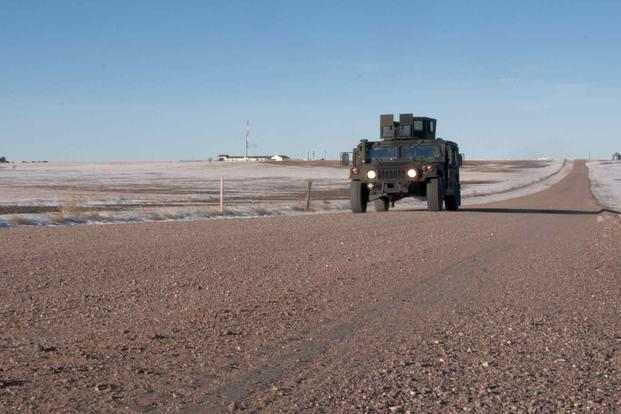Air Force officials at the nation's nuclear missile bases are reexamining the way they train with Humvees after two airmen died in the vehicles late last year.
The 20th Air Force, the numbered combatant command that oversees intercontinental ballistic missiles at bases and sites in the western U.S., initiated "a deliberate pause coupled with a reassessment of training, certification, and employment" for airmen using the Humvee, said Col. Brus Vidal, an Air Force Global Strike Command spokesman.
News that the bases are modifying the use of the vehicles comes after an airman died in Colorado in September and another died in Montana in October. Military.com learned that the use of the vehicles was being reexamined during a visit to F.E. Warren Air Force Base in Wyoming this month.
Read Next: Pandemic-Related Backlog of 600,000 Veterans Records Requests Finally Cleared
Airman Trinity Reinhart, a 19-year-old security forces member from Oregon, died Sept. 16 in a Humvee incident near Grover, Colorado, F.E. Warren Air Force Base said in a news release.
"We offer our deepest condolences to Trinity's family and friends," Col. Justin Secrest, 90th Security Forces Group commander, said in the news release. "Losing one of our own is extremely difficult. We are grateful for the support from our surrounding communities during this heartbreaking time, especially the Colorado first responders who assisted at the scene."

Nearly a month later, on Oct. 21, Airman Alton John, a 19-year-old security forces member at Malmstrom Air Force Base in Montana, was injured in a vehicle incident, according to the base. A Montana Highway Patrol report shared with local media outlets said that the Humvee attempted a downhill right-hand curve "at an excessive rate of speed for the vehicle," adding that it crossed into the other lane, spun and then left the road, where it rolled "multiple times."
John died six days later, Malmstrom said in a Nov. 1 news release.
"This is a loss that will be greatly felt by each and every member of Team Malmstrom,"
Col. Barry Little, 341st Missile Wing commander, said in a news release at the time.
In both incidents, a second airman was in the vehicle but survived. In both cases, the Air Force initiated an Interim Safety Board following the mishap to gather information. Additionally, a Safety Investigation Board was started to examine the cause of the crashes.
Those recommendations, although the findings were not made public, have been put in place.
"Although we can't discuss the safety investigation results of these two tragic mishaps, the command has implemented the recommendations of the safety board president," Vidal said.
The 20th Air Force first announced the modifications to how the Humvees would be used in operations in December.
"Last month, the 20th Air Force commander directed a modification to the way Up-Armored (UA) Humvees (HMMWVs) are used in operations," Vidal said. "Although their use profile has been modified, missions will continue to utilize UA-HMMWVs when required."
Specific details of how their use will be modified for training or operations was not provided by Air Force Global Strike Command, but Vidal said the Humvees can still be used operationally when required.
Humvees are often used by security forces airmen to drive out to, patrol and transport people from missile launch centers located in remote, rocky and sometimes dangerous terrain of the Great Plains throughout Montana, North Dakota, Colorado, Nebraska and Wyoming. Frequent cold weather and snow in these areas also make driving conditions more hazardous.
The airmen's deaths and the 20th Air Force's reexamining how they use Humvees come on the heels of heavy scrutiny in recent years of rollover deaths during training.
A 2021 Government Accountability Office report pointed to failings within the Army and Marine Corps that led to rollover fatalities. That 103-page report revealed that training inconsistency and overconfidence led to deaths, as well as a lack of safety personnel who can identify hazards during exercises.
From 2010 to 2019, those services reported 3,753 non-combat accidents resulting in 123 service member deaths, the report found. Rollovers were the most deadly accident, accounting for 63% of the fatalities.
Since 2019, nine airmen have died in government-owned vehicles, according to Air Force Safety Center data.
Most recently, in 2022, Military.com reported that an Air Force ROTC cadet was killed and two others were injured in a Humvee incident at Saylor Creek Range, part of the Mountain Home Range Complex in southwestern Idaho, during a training exercise.
Related: Air Force ROTC Cadet Killed, 2 Others Injured in Humvee Training Accident













